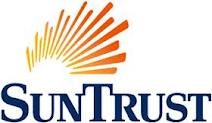Atlanta-based regional lender SunTrust Banks (NYSE:STI) reports fourth-quarter earnings at the end of this week. If it wants to impress analysts, as opposed to depress its shareholders, it will need to post improvement in most if not all of the following areas.
1. Net interest margin
This is arguably the most important statistic in all of banking. It measures the spread between the yield on a bank’s earning assets and its cost of funds.

In SunTrust’s case, its third-quarter figure stood at 3.38%. To give you additional context, BB&T‘s was 3.94%, PNC Financial‘s 3.82%, and M&T Bank‘s 3.77%. Suffice it to say, then, investors should watch closely to see whether SunTrust’s fourth-quarter figure can begin to narrow this gap.
2. Credit quality
If there’s one reason banks underperform or even fail, it’s because they make or otherwise own bad loans. This is the reason Washington Mutual and Wachovia collapsed in 2008 before being acquired by JPMorgan Chase and Wells Fargo . And it’s why Bank of America and Citigroup have struggled so much in the aftermath of the crisis, recording billions of dollars in credit losses.
The best metric for assessing a bank’s credit quality is the nonperforming loans ratio — which measures the proportion of a bank’s total loans that are either in or on the verge of default. In good times, you want to see this figure in the 0.3% to 0.5% range. Right now, however, a relatively respectable figure comes in around 1%, plus or minus 10 basis points.
In SunTrust’s case, its third-quarter figure stood at 1.45%. Consequently, you want to see that figure improve in the fourth quarter.
3. Expenses
At this point, I’m sure you’ve heard about the job cuts on Wall Street. Morgan Stanley just announced that it’ll be laying off 1,600 employees in its institutional securities business, both Citigroup and UBS are already in the process of slashing more than 10,000 employees each, and Bank of America is looking to cut $8 billion in expenses from its annual budget.
Why the cuts? New regulations have tamped down on traditional revenue sources, reducing things like overdraft and interchange fees and requiring banks to hold more capital. In order to maintain a respectable level of profitability, in turn, banks need to closely manage their expenses.
In SunTrust’s case, in the fourth quarter of 2011, the comparable quarter for this metric, its noninterest expenses stood at roughly $1.6 billion. As above, you’ll want to use this number as a benchmark for the figure from the fourth quarter of last year.
4. Return on equity
In a perfect world, you’d like to see double-digit ROE figures at any bank you invest in, as anywhere between 12% and 15% was traditionally considered respectable. Since the housing bubble burst, however, the industry overall has had to rebuild its profitability, going from a negative 11.6% ROE in the fourth quarter of 2008 up to a positive 9.4% in the third quarter of last year, with lenders like Wells Fargo even remounting the double-digit range.
In SunTrust’s case, its fourth-quarter 2011 figure stood at a miserable 1.59%, far below essentially all of its regional bank competitors. So again, you want to see this figure improve in the fourth quarter, and ideally in a major way.
There you have it
These are the four things you’re going to want to watch for when SunTrust Banks’ reports earnings at the end of the week. In the meantime, to learn the identity of the “only big bank built to last,” simply click here now.
The article Will SunTrust’s Earnings Impress or Depress? originally appeared on Fool.com.
John Maxfield owns shares of Bank of America. The Motley Fool recommends Wells Fargo. The Motley Fool owns shares of Bank of America, Citigroup, and Wells Fargo. Try any of our Foolish newsletter services free for 30 days. We Fools may not all hold the same opinions, but we all believe that considering a diverse range of insights makes us better investors. The Motley Fool has a disclosure policy.
Copyright © 1995 – 2013 The Motley Fool, LLC. All rights reserved. The Motley Fool has a disclosure policy.
